On the Edition of the Complete Works of the Rhétorique des Dieux’s Notator B, and on the Gaultier Catalog Raisonné [1]
François-Pierre Goy (Paris) & Andreas Schlegel (Menziken/Basel)
Lecture held on 1 Mai 2013 at the festival of the German Lute Society in Bremen. This version published, with Additions, in August 2016.
Introduction (FPG)
The project which we present today to you was originally thought to produce a ‚classical‘ facsimile edition of a small manuscript in the private collection of Matthias Schneider, supplemented by an introduction. But although this source is a small one, it does not lack importance. The hand of its copyist can be found in no less than five other sources, among which is one of the most famous lute manuscripts, La Rhétorique des Dieux. Because his hand appears in the Rhétorique as the second music hand or notator, Andreas Schlegel has a number of years ago given the name „Notator B“ to this lutenist. The project thus developed gradually, and the edition will now comprise facsimiles of two complete manuscripts, some facsimiles from other handwritten lute books, and extracts from further sources in transcription. This brings all works written by Notator B together and allows to compare them. For most of them parallel readings from different sources will be given. An extensive introduction will contain a discussion of every aspect concerning Notator B and the sources. Last but not least let me mention my Gaultier Catalog Raisonné, about which I will talk later.
Let us begin now with the Transmission of the Works of Denis Gaultier:
Transmission of the Works of Denis Gaultier (AS)
38 years ago, in 1975, Éditions Minkoff published after the original copies held by the Bibliothèque nationale de France (F-Pn) both of the prints which claim in their titles the authorship of Denis Gaultier:
- the Pièces de luth de Denis Gaultier sur trois differens modes nouveaux, then dated to “ca. 1670”, and
- the Livre de tablature des pièces de luth de Mr. Gaultier Sr. de Nèüe et de Mr. Gaultier son cousin, sur plusieurs diferents modes avec quelques reigles qu’il faut observer pour le bien toucher, then dated to “c. 1680”. These were published in the form of black and white reproductions without gray-scale values, and this may have had consequences for the history of research in Gaultier and his music.
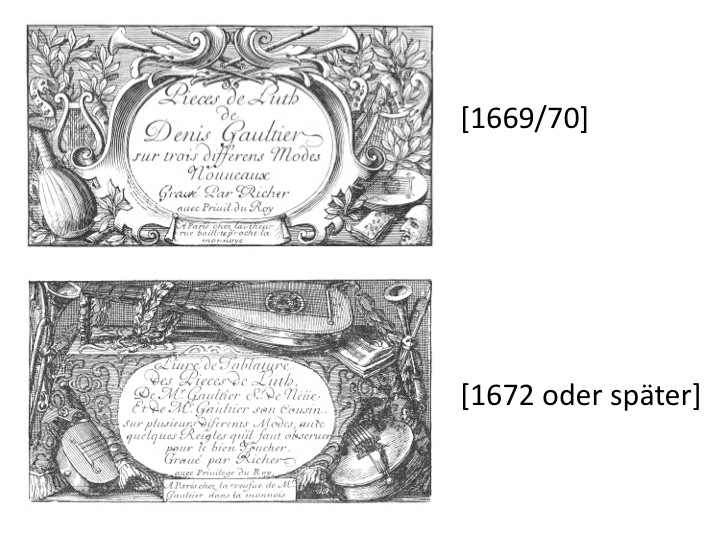
37 years ago, in 1976, Hopkinson Smith’s recording Denis Gaultier: La Rhétorique des Dieux appeared, containing the suites in D major, A major, and A minor, played on an instrument by Pietro Railich in the Germanisches Nationalmuseum in Nuremberg.
The album notes by Marie-Madeleine Krynen were the basis for what I internalized during my studies at the Schola Cantorum Basiliensis:
“Neither post nor official title bind him [Denis Gaultier] to the Royal court. He practices his art among the courtiers and artists, and certainly earns his living by giving lessons, and with the help of benefactors. […] From his wealthy patrons Anne de Chambré is the one best known to us. An art and music lover at the same time, he honors our musician and his instrument in the highest degree imaginable by collecting those pieces, which he thinks are the most beautiful ones, in a magnificient manuscript. Thus the Rhétorique de Dieux was created around 1652. Naturally it was meant for Anne de Chambré’s own personal use.”
Together with the two prints, the Rhétorique was held to be one of the main sources for the works of Denis Gaultier, and this ‘canonic’ trinity was hardly ever questioned. After I discovered in 1987, while examining a microfilm of the Rhétorique, that paper leaves had been inserted into this parchment manuscript, I began to scrutinize and to doubt what for many seemed to be a matter of course.
I have explained in several articles why the Rhétorique was obviously not completed as it had been intended: [2]
- There are many pages left void instead of being filled with pieces
- The music has been entered by two music hands: Notator A and Notator B
- The versions of the pieces offer partly contradictory readings to those which are contained in the prints or transmitted via other sources
- Sections of the book have been rearranged, with the consequence that there are contradictions to what the preface states
- Some illustrations are missing, etc.
In May 1987 I gave to my first study of the Rhétorique the title The Codex Hamilton [an alternative name for the Rhétorique] as peripheral source of Denis Gaultier’s works. [3]
Long years of collaboration with François-Pierre Goy brought about an ever growing complex of new findings. In addition I realized that hardly ever in the transmission of French lute music the personality of the respective scribe is without influence.
For the whole of transmissions of a given piece I have coined the term transmissional spectrum. This comprises all versions of a work including the copying mistakes, omissions, additions, and variants. Close examination reveals a common core between the versions which in principle is always the same but which shows differences in the way the music is brought into a definite form. What shows here is the field of personal adaption which I have called formulational latitude in order to mark off the difference from errors and variants. It is of course possible to encounter pieces which circulated in two variant forms with a formulational latitude to each of these forms.
This perspective led to a special emphasis on the question of how a writer or notator has formulated a piece in different sources. A rewarding example to turn to is in this respect Julien Blouin who has entered 85 lute and 11 guitar pieces into 6 sources – but only three works in two different versions each, and only one in three different versions.
When the manuscript D-Fschneider Ms. 12 (formerly in the possession of Robert Spencer) came into focus, the greater part of which was written by Notator B, , the project to collect and edit all 33 pieces written by him into 6 sources started (among the pieces one was written twice into a source, three pieces appear in two sources, and one piece appears in three sources).
Five of the pieces written by Notator B into at least one of his sources are also to be found in the print Pièces de luth (the Tombeau de Lenclos in A minor and his variants in B minor have been counted as two different pieces), nine others also in the Livre de tablature. Nine pieces and one Double are unica – they are only to be found in one of Notator B’s sources, three of them and the Double in the Rhétorique. Thus Notator B allows deep insights into what I have called formulational latitude.
We will turn now to the three lute books which are supposed to be the main sources of Denis Gaultier’s music, beginning with the Rhétorique and the persons behind the Rhétorique des Dieux. François-Pierre Goy’s research into their biographies forms an important part of our edition.
The persons behind the Rhétorique des Dieux (FPG)
I am of the opinion that for anyone who studies a manuscript it is of importance to learn as much as possible about the life of those involved with this manuscript. In the case of the Rhétorique there is (apart from Denis Gaultier and the anonymous music writers) a considerable number of persons connected with it: Anne-Achille de Chambré, who commissioned the manuscript, and several other members of his family, various artists, calligraphers, and the authors of the sonnets.
Since my article about the family Chambré appeared in 1996 [4] important documents have newly surfaced. Unfortunately I also had to notice that other documents of similar importance have gone missing in the meantime. I have traced the Chambrés from the first half of the 17th century to the mid-19th century through six generations, although in our edition I will only cite those documents and data which relate to the Rhétorique. A complete presentation of all the family members which I know about is planned to appear as a separate publication.
Searching in French archives for a person who has lived in the 17th century comes close to a treasure hunt, beginning with a trace found in a first document pointing to other documents – often backwards in time. To search for the needle in the haystack, at least a personal or place name, a time span or a document to start with is necessary. Then a trace may get lost again, for example because a person moved to a new place of residence that remains unmentioned.
Most of the biographic data to appear in our edition come from parish registers (namely baptismal, marriage, and funeral records), and from the archives of the Paris notaries, where marriage contracts, tenancy agreements, testaments, and inventories can be found. The latter are especially valuable as sources of information because they describe (sometimes in detail) and assess the value of the residence and the property of the deceased. I have consulted other archival sources only when finding aids with indexed names were available for these. Otherwise archival holdings resemble uncharted territories, and years spent day in, day out in the reading room of the Archives nationales in Paris would be necessary to look through them.
In the earliest generations, those Chambrés known to us served as officials in the military or the tax administration. From the third generation on we find them as military officers. The family tree and the chronology (see Appendix 1 and Appendix 2) present the main facts and data concerning the family Chambré, therefore I will concentrate in the following on a few, but important discoveries.
The inventory of Anne-Achille de Chambré did not, as I had expected, list his possessions in all completeness, but points to earlier documents instead. [5] Nevertheless I learned from it that Geneviève Benoist, his second wife whom he married in October 1652 and who is also mentioned in the preface to the Rhétorique, obtained in 1662 the legal separation of property, and became heir as creditor of her husband. [6]
In the inventory four paintings by Eustache Le Sueur are specially mentioned, a theorbo, and an anonymous painting showing the naval battle near the isle of Saint-Christophe (today: Saint-Kitts). The discovery of a drawing by a certain J. Senault dedicated to Chambré and depicting this battle of 1667 was a big surprise. [7]
In the drawing the same coat of arms is to be seen as in the Rhétorique. The drawing of the battle is probably copied from the painting which hung in Chambrés house.
In the second generation there are two persons who are connected with the Rhétorique.
Anne de Chambré, the daughter from the first marriage whom Robert Nanteuil portrayed together with Denis Gaultier, must have been born after 4 November 1638, as her marriage contract of 4 November 1663 shows that she had not come of age yet and thus was not 25 years old then. [8]
From the testament of her husband Antoine Hubert, read on 7 May 1706, I learned that Anne died on 16 October 1677 in Dunkirk, but there is no trace of the Rhétorique in her inventory. [9]
Anne-François de Chambré, Anne’s half-brother from the second marriage of her father with Geneviève Benoist, was born in the 1650s.
When he died on 19 December 1711 in his house in Paris, the only close relative to attend to him was his niece Anne-Geneviève Hubert, a daughter of Antoine Hubert and Anne de Chambré. She saw for the sealing of the home by the legal authorities, [10] before the wife of Anne-François, Marie-Françoise Nau (who had in 1701 obtained a separation of property and lived now in Le Havre, the town of her birth), and his eldest son Barthélemy Jean-Baptiste de Chambré returned to Paris and had an inventory of the deceased’s possessions taken. [11]
The document which records the sealing of Chambrés home makes it almost possible to view the scene with the eyes of the commissioner from the Châtelet: It is one o’clock in the morning. We arrive together with commissioner Nicolas Labbé at the house of Anne-François de Chambré, climb the stairs to the second floor and enter the room in which Anne-François de Chambré has been lying dead on the bed straw for four hours. We meet those present, among them the landlady with her son, the priest of the parish Saint-Paul who administered the last rites to the dying man, and Anne-Geneviève Hubert who tells us where the wife and the children of her uncle are at the moment. The servant Élizabeth Larue leads us through the several rooms in order for us to seal these. Together with the information furnished by the listing und detailed descriptions from the inventory it is almost possible to envision the scene.
One of the most thrilling moments in my research came with the discovery of what Anne-François de Chambré kept in a “small lumber room which served as a kitchen” [petit bouge servant de cuisine]: In a cupboard there were a syringe made of tin, articles of clothing, tablecloths, a small sabre, and “a lute book with several copperplates [sic!] bound in shagreen, with clasps and ornaments of copper, with its bag of cut velvet, estimated to 20 Livres”. [12]
This description fits the Rhétorique exactly and proves that the book had remained with Anne-Achille de Chambré, and was then inherited first by Geneviève Benoist and later by Anne-François de Chambré. Luckily Anne de Chambré, although her portrait appears in the Rhétorique, did not possess the manuscript, for if she had it would probably have been destroyed when the house of her husband Antoine Hubert in Dunkirk burned down.
It is uncertain what happened to the Rhétorique during the forty years after the death of Anne-François de Chambré, who himself already seems not to have estimated it very highly. At the moment we even do not know how long the manuscript remained in the possession of the family Chambré.
Marie-Françoise Nau became as creditor to the inheritance of her husband the owner of his property.
She survived him for more than thirty years and died in June 1742 in Le Havre. [13]
The last trace of Barthélemy Jean-Baptiste de Chambré is detectable with his presence at the funeral of his brother-in-law Louis Georges Feudrix de La Fontelais in Montivilliers, two months before Marie-Françoise Nau died. [14] Although Barthélemy Jean-Baptiste had for years lived together with his wife in Le Havre, there is no documentyation of his burial there. Did he go back to Paris, where his son Barthélemy Alexandre died at an early age on 26 January 1743? At the moment there is no indication as to where to look for him in records in Paris.
Thus at the moment it is neither possible to learn who presented the Rhétorique to the famous copperplate engraver and critic Pierre-Jean Mariette, nor who had it sold in August 1751. Was the manuscript then still in the hands of the Chambrés? Had they sold it shortly before, so that it may have been shown to Mariette by a new possessor? Or had the Rhétorique already changed hands several times?
The complete sequence of possessors from 1751 on, which we have established for the first time in our edition, is shown in the Chronology (Appendix II). The second last of these, Thomas Thurlow (1731–1806), has been previously unknown. For each of the possessors we have given a more precise identification than has been done before, including the first name, biographical data, and citations from the auction catalogs.
Concerning those who participated in the production of the Rhétorique, I have cited new findings only when someone had not been previously identified. As a hypothesis I suggest the identification of the bookbinder Ferrier with Pierre Ferrier, bookbinder and gilder, even though I could only find few data concerning this person.
The youngest of those who had a hand in the creation of the manuscript were the two calligraphers. The writing master Étienne Damoiselet, born around 1629 and deceased in 1678, who taught the son of Louis XIV, the Grand Dauphin, to write, has been identified as one of the Rhétorique’s writers already long ago. This has been hitherto ignored in the literature on the lute and its music. The contract of his marriage [15] and his inventory – which both remain unpublished as yet – provide interesting information about him and his family. The possibility that he was related to the painter Florentin Damoisellet can now be excluded. It is remarkable to learn that Étienne Damoiselet’s brother Jean traded with parchment, for the Rhétorique is written on parchment.
The identity of the second calligrapher, François Belluchau, had never been completely uncovered. I was able to identify him by way of comparison with the yearly États de la Marine (registers of the navy), which he wrote vom 1670 to 1692. This second youngest of the Rhétorique’s producers was born in 1635 in the seaport Brouage. [16] In 1667 he became commissioner of the navy in Marseille and two years later first commissioner of the navy (premier commis de la Marine), a position comparable to that of a chief of cabinet to the minister of state, Jean-Baptiste Colbert. In 1674 he bought the post of a secretary to the king. He died between 1696 and 1699. Like Chambré, Belluchau owned a collection of paintings, but he seems not to have had a special interest in music. Unfortunately I have not yet found any information about his activities prior to 1667, when the Rhétorique was created.
Notator B and the Prints of Gaultier (AS)
Let us now leave the Rhétorique and turn to the prints, beginning with the Pièces de luth.
Because Notator B has also written the beginning of a Courante in D major into the Paris copy of the Pièces de Luth, we took a closer look at the prints, starting with the facsimile edition by Minkoff. Joachim Lüdtke’s discovery of differences between several copies of prints by Newsidler, my own observations on differences between the copies of Vallet’s prints, and an article by Bruce Gustafson (who has made similar obersvances in the extant prints of Chambonnières) had made me aware of the possibility of surprises. It came therefore not unexpectedly when in Januar 2012 I discovered that some characters in the Pièces de luth did not appear to be engraved characters, but may have possibly been added by hand. François-Pierre Goy verified this by examining the originals in Paris, and thus the next surprise came to light: Someone has supplemented the musical text of the Pièces (and only this book alone) with entries which add predominantly right-hand signs to the music. Do you recognize the additions?
In the following illustrations, two such entries (a corrected tablature letter and a stroke designating the use of the thumb) are highlighted in the page were they occur, and then shown enlarged.


Corrections in Pièces de Luth, copy F-Pn Rés. Vm7 375, p. 41

The illustration above shows a correction done by erasing a printed g and writing over an f by hand. Below shows a supplemented stroke indicating the thumb plucking the fifth course (right hand side, the stroke to the left ist printed).
The Paris copy of the Pièces – F-Pn Rés. Vm7 375 – is one of three surviving copies known today. On 22 December 1669 had Denis Gaultier his privilege registered with the guild of the book traders (Chambre syndicale de la librairie), a privilege which he had been granted not only for his own works, but also for the pieces of “feu Aymond Gaultier son cousin” – his late cousin Ennemond Gaultier. But in contrast to many other music prints which have been registered with the Chambre Syndical, no deposit copy of the Pièces de luth seems to have found its way into the collections of the then Royal library. The copy with the shelfmark Rés. Vm7 375 was obtained by the library only almost a century later. It carries the seal “Bibl. de Falconet”, which shows that it came from the large library of Louis XIV’s physician, Camille Falconet, who lived from 1671 to 1762. Prior to auctioning the library after Falconet had died in 1762, the librarians were allowed to take all those books which were lacking in the Royal library from Falconet’s collection in order to incorporate them into the Bibliothèque Royale.
Marguerite Monin and the Paris copy of the Pièces de luth (FPG)
For our edition we have also investigated the lifes of those persons which are connected with the Paris copy of Denis Gaultiers Pièces de luth. This is especially true for the former holder of this copy, Marguerite Monin (1649–1689), a citizen of Lyon [17] who is also connected with a famous Angélique and lute manuscript: Vm7 6212 of the Bibliothèque nationale de France. I hope to describe her life in detail in a future article, together with the biographies of the lutenists in Lyon. Our edition contains an outline of her biography with the basic data.
The two editions of the Pièces de luth (AS)
The identification of the manuscript additions in the Paris copy of the Pièces made it necessary to revise my survey concerning playing technique in Denis Gaultier’s music, because this was based on the Minkoff facsimile. As copies of both prints by Gaultier are also among the library holdings of the princes Lobkowicz, I assumed that a comparison between the Paris copy of the Pièces and that in the Lobkowicz collection would answer questions concerning the playing technique, and could help to explain the manuscript additions. Both copies had to be consulted where they are kept, and examined carefully. One of the consequences of this was a further delay of our edition. In the meantime we have identified a third copy of the Pièces in Oxford, which we have not yet included in our investigations.
In January 2013 I could examine the prints in Paris. Ongoing work on the registration of the Lobkowicz collection and the lack of a study room in Nelahozeves has meant that I was not able to consult the copies held there. I am indebted to my friend Jan Čižmář who in April 2013 examined those copies for me. The result was another surprise: Almost all of the manuscript additions to the Paris copy appear in print in the copy of the Lobkowicz collections. The papers of both copies of the Gaultier prints in this collection show a very similar (if not identical) watermark, which is clearly different from those found in den Paris copies.
Unfortunately I am not yet able to show pictures of the Lobkowicz copies, but comparisons of the different prints will be shown in the edition.
What follows from these discoveries? As there are no erasures where the additional signs into the Paris copy of the Pièces have been entered (with the exception shown above), the Lobkowicz copy can be seen as a corrected new edition. This raises the question of who has entered the corrections in the Paris copy, and when this was done:
- Was it the engraver Richer, or the printer (the possibility that these were different persons does exist)? What was the source?
- Was it Denis Gaultier himself?
Both these possibilities would mean that the corrections were entered prior to selling the book.
- Or was it the person who had obtained the book, or someone who used it? Marguerite Monin? Notator B? Montarcis?
It is certainly not possible to answer these questions anymore, but we notice that corrections for a new edition were engraved into the copper plates following the printing of the first edition, which certainly had been produced when Denis Gaultier was still alive. The question if the corrections also date from Gaultier’s lifetime may be difficult to answer, unless there should be a proof that the watermark in the new edition’s paper was in use only after his death (Gaultier died between 31 January and 5 February 1672).
The discoveries described above lead to doubts concerning the assumed exceptional authority of two sources: the Rhétorique and the printed Pièces de Luth. Let us now look at the third main source, the Livre de tablature.
I has long been known that a certain Monsieur de Montarcis wrote at least the latter part of the preface to the Livre. There he announces a work which describes the playing technique of Denis Gaultier, and he points to recently published plates with compositional rules and the division of the lute neck. There is no copy of any of these prints known to date, but the register of the book trader’s guild (Chambre syndicale de la librairie) contains the following entry:
“4 July 1672. Mr. Girin, publisher in Lyon, has presented to us a privilege which allows him to print a book with the title The Art to Learn Independently and Without Much Effort in a Short Time to Play on the Musette, together with Theory and Practice on the Lute. This privilege is valid from 16 February 1672 for 10 years.” [18]
The anonymous Traité de la musette, which is ascribed to Charles-Emmanuel Borjon de Scellery, was in fact printed by the publisher Jean Girin from Lyon on 1 June 1672. The book contains an excerpt from the privilege which is dated to 15 February and mentions the book als Traité de la musette, & c., but neither the book’s text nor the excerpt from the privilege contain a mention of the lute. Did Girin receive the privilege for two different works of which only one actually appeared or is extant, or was the Traité de la musette originally to contain a part devoted to the lute? This Théorie et pratique sur le luth might correspond with what Montarcis announced, although one 19th-century historian mentions this treatise as an unprinted work of Borjon de Scellery.
Monsieur de Montarcis (FPG)
I would love to be able to reveal the real name and identity of the mysterious Monsieur de Montarcis, the editor of the Livre de tablature. The only other 17th-century man named Montarcis whom I could find, a certain Pierre Baudouin de Montarcis, has so far been known for his writings: Two philosophical treatises printed 1651 and 1668, [19] and a large number of manuscript treatises which are today kept at the Bavarian State Library in Munich, and are not only on philosophy, but on diverse matters with the exception of music.
I was the first researcher to investigate his life. Here it must suffice to say that although he was exactly a contemporary of Denis Gaultier, he can in all probability NOT be identified with Gaultier’s pupil. And because I could not find more documentation concerning his two sons than their certificates of baptism, it is even not possible to learn if our Monsieur de Montarcis was a member of this family. [Addition 2016: My further research on him has however shown that he can without doubt be identified with Gaultier’s friend – but also that he may not have been a pupil of Gaultier –, and that the younger Pierre Baudouin, Sieur de Montorsy (1644–1722), was a lute amateur too. The role played by Montarcis in the publication of the Livre de tablature can now be described more precisely, although not completely. See my article Pierre Baudouin de Montarcis, un lulliste français du Grand siècle, which is to appear in Studia Lulliana.]
Let me close with relating an amusing occurrence:
In 1670, Pierre Baudouin de Montarcis became entangled in a kidnapping. In his house lived a penniless Scotswoman who had been in the service of the Duchess of York earlier. Her brother had made contact with a young English nobleman who had come to Paris on a Grand Tour, and kidnapped him after a drinking bout in order to have him marry his sister. Montarcis became instrumental in finding a priest who consented to perform the illicit wedding. However all persons involved were taken to court, and Montarcis received a fine as an accomplice in the case. He died in 1685, 84 years of age.
The Peculiarities of the Livre de tablature (AS)
Let us now have a look at the contents of the Livre de tablature. What draws attention first is a mistake in the pagination:

Page | Content of the Livre de tablature
1 | Title page Livre de Tablature
2 | Beginning of the …
3 | Continuation of the …
4 | Continuation of the …
5 | Continuation of the …
6 | Continuation of the …
7 | Continuation of the …
8 | Continuation of the … Text by Montarcis
5 | Continuation of the … Text by Montarcis
6 | …. [D minor]
7 | …. [D minor] with Accord …
8 | …. [D minor]
Different from the preface to the first print, the Avertisement au Lecteur here comprises eight pages, not four. The first music page is counted as 6, and the previous page on which the preface ends is counted as 5, but the other pages with the preface are counted from 2 to 8. Page numbers 5 to 8 appear twice, and the sequence of page numbers is thus 1 2 3 4 5 6 7 8 5 6 7 8.
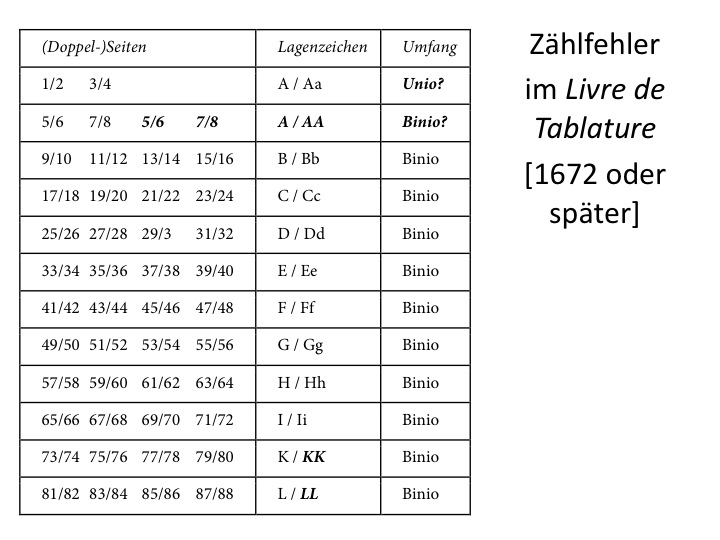
Mistakes in the pagination of the Livre de tablature [1672 or later]
(Double) Pages | Gathering Signature | Size
In addition to the incorrect pagination, the gathering signatures also show inconsistencies, beginning with “A” on the title page and “Aa” as a counter signature on page 2, then repeating “A” on page 5, going on with “AA” on page 6, and showing from page 9 on a fairly regular pattern of signatures and their counter signatures in alphabetical order with additional lower case letters marking the second page of each binio (4 pages in the gathering) – only the last two gatherings show upper case letters for this.
A comparison of both prefaces – in the edition they will be printed in parallel columns – shows that in the Livre de Tablature phrases are more elaborate and long-winded, the music examples are given more space, and there is the additional text by Montarcis. Is it possible that Denis Gaultier had calculated this preface also to four pages, and that Montarcis had it expanded to double its size? Did the process of engraving the music begin while Denis Gaultier was still alive?
A second conspicuous feature of the Livre de tablature are the three distingishable layers of its contents:
a) Music by Denis Gaultier which is notated in a similar or even identical fashion as in the Pièces de luth (for example the pieces in D minor: Prélude D minor pp. 6f., remaining music pp. 20–31).
b) Music by Ennemond Gaultier which almost completely lacks right-hand signs (D minor pp. 8–19, D major pp. 34–41, G minor pp. 52–61).
c) Music by Denis Gaultier which also shows a considerable lack of right-hand signs and thus deviates from the custom established with the first print and followed in a large part of the second (for example Prélude D major pp. 32f., Prélude B minor pp. 68–71).
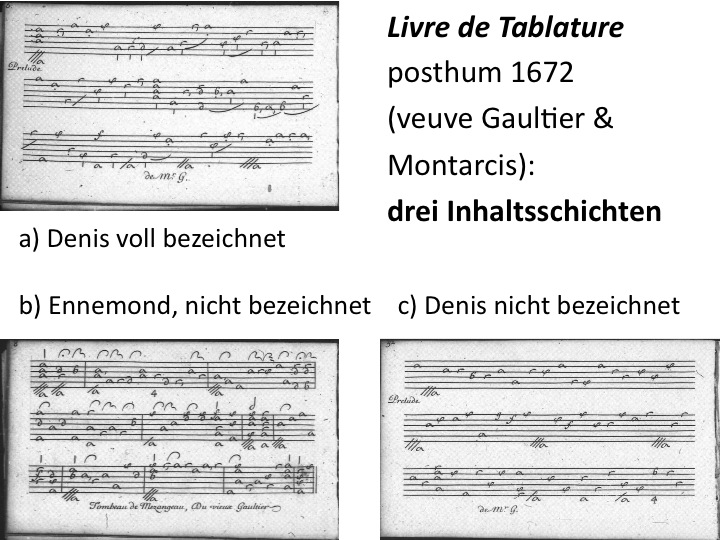
Livre de tablature, published posthumously in 1672 by Gaultier’s widow and Montarcis: three content layers
a) Denis, with complete right-hand fingering
b) Ennemond, without fingering
c) Denis, without fingering
It is not always possible to clearly differentiate between the notations of layers a) and c). For example only the Préludes pp. 32f. and pp. 68–71 are totally free of right-hand fingering indications. Printing a kind of notation which deviates so clearly from the “editorial guidelines” signalized by the first print, which can more likely be understood as being authoritive than the later one, means that the music printed so has not been edited by Denis Gaultier. The authenticity of all the pieces in the Livre de tablature is thus discredited: Denis Gaultier may perhaps have had a hand in the versions engraved into the copper plates, but it is also possible that he did not. It is therefore necessary to analyze every piece regarding the correspondence of the notation with that which was used in the first book.
It can in addition be observed that even in the content layer b) right-hand signs appear here and there, although without system or particular features in the places where they appear which might have motivated it to place them there. The end of the first of the two Préludes from layer c) may serve here as an example:
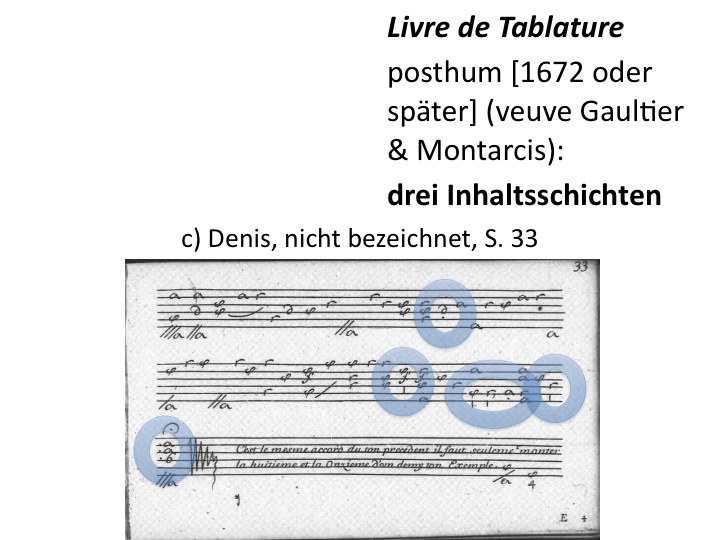
Line 1, last appearance of 4d: point.
Line 2: short vertical strokes indicating plucking with the thumb.
Line 3: final chord marked with tirer points.
How then did the engraver work when copying from his source material? Did he follow editorial instructions? Did he engrave exactly what he had before him? Did he follow his own preferences? It can be suspected that the engraver actually had material to copy from, which included right-hand signs, but that he had been asked to leave these out, and occasionally forgot about this. Might it be possible to ask similar questions concerning the first book?
The third main source of Denis Gaultier’s music is so bereaved of its special authority too. In order to arrive at conclusions regarding authoritative musical texts it is only possible to collect as many versions of a given piece, play them and so approach the core substance of the music. For this a register of concordances is necessary, and this is exactly what François-Pierre Goy makes available with his Gaultier Catalog Raisonné. It will be another part of our edition French 17th-Century Lute Sources with Participation of Notator B of the Rhétorique des Dieux.
The Gaultier Catalog Raisonné (FPG)
The edition was originally planned to appear in a customary format with complete lists of concordances for all the sources containing music written by Notator B, but littly by little the concept widened and developed into the idea of an catalog of all works marked with the name Gaultier which appear in lute sources.
The works of Denis, Ennemond, and Pierre Gaultier have so far appeared in three volumes of the series Corpus des luthistes français. [20] While the contents of the volume devoted to Pierre Gaultier correspond with that of his 1638 print and thus did not pose editorial problems, the editors decided to include in the two other volumes only those pieces which are unequivocally marked with the name of the respective composer. In the case of Vieux (Ennemond) Gaultier this was done without assessing the ascriptions. The edition of the pieces in the Corpus des luthistes is therefore not ccompletely satisfying. There are for example pieces like the Courante Le canon which appear both in the volume devoted to Vieux Gaultier as in the one devoted to Denis Gaultier. The Courante La Champré, which in most of the sources is ascribed to Denis, has appeared in its more common form among the works of Vieux Gaultier and in a rather uncommon variant among those of Denis Gaultier. In addition all of the pieces which appear in the sources marked with “Gaultier” without a more precise ascription have not been included in any of the volumes. Finally has the corpus of the Gaultiers’ music been growing in the last years with sources becoming available again, for example the manuscript SA 4060 of the Berliner Singakademie, containing thirteen Gaultier unica and several ascriptions to Gaultier of pieces which hitherto were held to be anonymous.
My intention was to supply with the Gaultier Catalog Raisonné a tool for future research, which would represent my present knowledge, not a definite work. Especially the ascriptions to Vieux Gaultier might be worth a critical assessment. [Addition 2016: In the end it was decided not to publish a separate Gaultier Catalog Raisonné with the edition. Instead the edition will contain only the concordances to the pieces in the sources covered by the edition. The material collected so far for a Gaultier Catalog Raisonné will be integrated into an electronic catalog, a data bank cataloging 17th-century lute music, which will follow the same guidelines as the Gaultier Catalog would have. Appendix 3 shows an example from the Gaultier Catalog Raisonné in the state ist was in in 2013.]
The catalog is divided into six sections counted with Roman numerals. Sections I to IV list the works which in the sources are ascribed to the lutenists Denis, Ennemond, Jacques, and Pierre Gaultier. Section V covers the small number of lute versions of pieces by Pierre Gaultier de Marseille, a contemporary of Lully. Finally section VI is devoted to those pieces, which the sources do not assign to any of the lutenists Gaultier specifically, but only generally to Gaultier. This section is subdivided into three parts: A for the pieces in Renaissance tuning (Vieil Accord), B for pieces in Accords Nouveaux, and C for works in D minor tuning and other tunings related to this. [Addition 2016: The future electronic catalog will be arranged following musical forms, like the PAN data bank.]
In each section I have chosen those criteria for arranging the pieces which seemed the best fitting in each individual case. With both of the Pierre Gaultiers I have maintained the order of the prints. With the others I have prefered arranging the pieces following the tuning, tonality, and form. When several different versions of a piece exist (for example in the case of those pieces by Denis Gaultier which are concordant to each other only with their respective first parts) the distinction is signalized by a letter added to the catalog number. This applies also to pieces extant in versions which differ in the tuning used or the tonality. For those parts of composite pieces which are not by Denis Gaultier, concordances are listed even when they are not by any Gaultier. These receive the same catalog number as the piece by Gaultier, but with the addition of an appendix number. [Addition 2016: In the electronic catalog the numbering inside each section for the different musical forms will be strictly consecutive.]
The catalog lists all pieces which have been ascribed to Gaultier in at least one source. Doubtful and apocryphal works are identified as such and are listed separately at the end of each section.
The catalog contains entries for 606 works: 516 by the different Gaultiers, 21 doubtfully ascribed and 33 apocryphal ones, and 36 versions by other composer. All in all I have been able to detect 2,219 records of works by the Gaultiers.
For each work the printed sources are listed first, followed by the manuscripts. Doubles have not received separate catalog numbers, but the catalog differentiates between source with and sources without Doubles. Following the sources of the regular lute versions of the pieces one finds first listed those sources containing Contreparties, and then versions for other instruments than the lute. I have been carefully examining the lute sources all by myself. As to versions for these other instruments, I have also consulted studies by others. This is especially true for the keyboard versions in Swedish tablature sources. I have therefore not tried to arrive at the same degree of differentiation with regard to these versions as with the lute sources. [Addition 2016: Later I decided not to cite from secondary literature any more, and to verify all of the versions by myself.]
For every given piece the source is cited, its location therein and a transcription of its title, and in addition further information (if thought to be useful) is given, for example: references to modern editions, the structure of the pieces which come with a Double, or the number of courses for the pieces in Renaissance tuning. This makes it possible to reconstruct the repertoire of certain lutenists, when it is scattered over several sources. [Addition 2016: Later I decided to describe all sources of all the pieces in a similar detailed manner.]
Differences between statements in the prefaces and the musical contents of the sources (AS)
A further point in our observations concerns the relation between what is stated in the prefaces of the sources (namely the Pièces de luth and the Livre de tablature), and what can be found in the music contained in these sources. While most lutenists will study the prints and prefaces, I have never met with anyone talking extensively about the differences between the performances signs shown and explained in the prefaces, and the performance signs which are actually used in the Gaultier prints. It is possible to find such differences, for example concerning dots printed behind tablature letters.
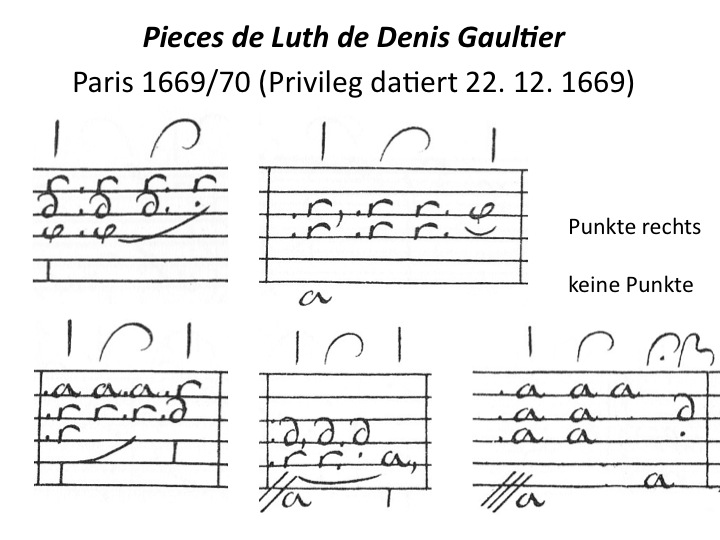
Pièces de luth de Denis Gaultier
Paris 1669/70 (the privilege is dated to 22 December 1669)
Dots to the right of tablature signs
No dots
The mysterious sign for the “Accent” (the mordent) only appears once in each of the prints! [21]
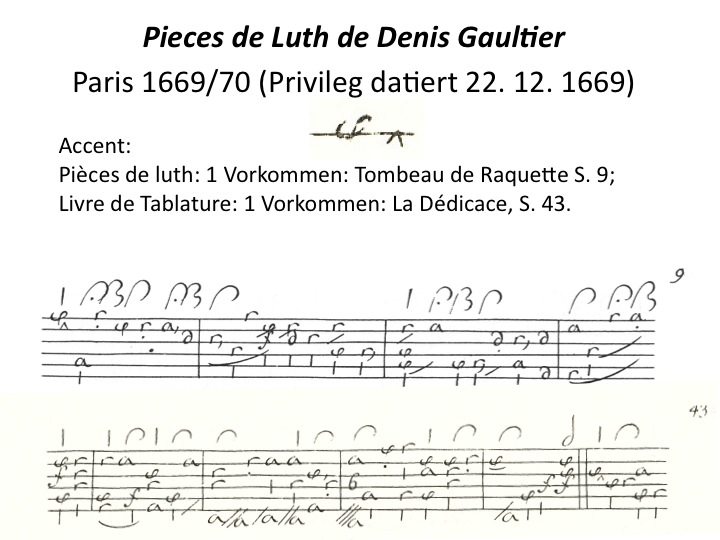
Accent:
Pièces de luth, single occurrence in the Tombeau de Raquette, p. 9;
Livre de tablature, single occurrence in La Dédicace, p. 43.
And Notator B employs it once in the manuscript FA VI 10 in Brussels – in the B minor version of the Tombeau de Lenclos of all pieces (fols. 26v–27r, measure 1).

Pièces de luth de Denis Gaultier, Paris 1669/70 (the privilege is dated to 22 December 1669)
Accent:
Notator B only in B-Bc FA VI 10, fol. 26v: B minor version
Tombeau de Lenclos
Why is it listed with the other signs like the trill, but is so seldomly used?
Turning now to basics: Not only do signs indicate something – the absence of a sign has also a meaning.
In the Gaultier prints, there is neither a sign for the middle nor for the ring finger of the right hand. But a tablature letter without a sign underneath explicitly means that the middle finger has to pluck. The use of the ring finger is implicitly excluded.
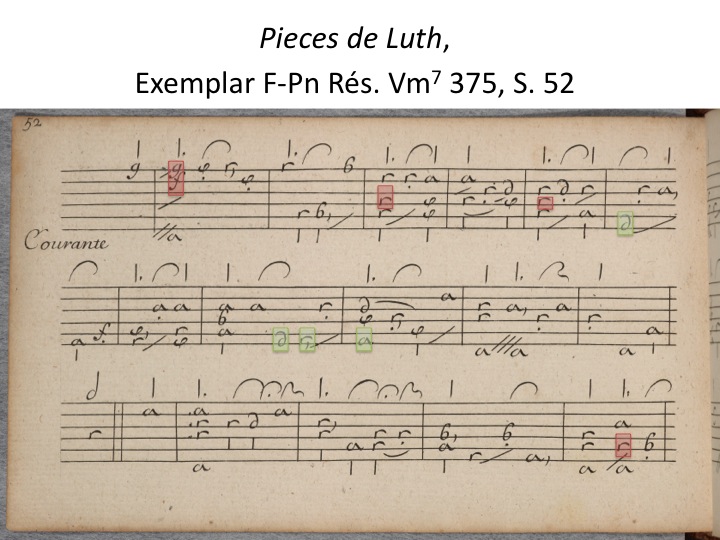
Pièces de luth, Copy F-Pn Rés. Vm7 375, p. 52
When we apply this rule consequently we are faced with problems in the places marked in red: There is no indication of the finger which is to pluck. Concerning the chords in measures 4 and 6 Gaultier instructs his reader to play the lower notes with the thumb and the respective upper one with the middle finger.
Gaultier has thus to supplement something in his instructions which can not be indicated by the signs printed in the tablature.
Now to the second possibility: Leaving out to indicate what is self-evident – in the places marked here in yellow. The sign indicating the thumb (the vertical stroke underneath the tablature letter) is on principle only used from the second to the fifth course. Only very rarely (although still in 18 of the 31 pieces in the Pièces de luth) is it used in the sixth, even less often (in only one of 31 pieces) in the seventh and eighth courses.
The omission of middle finger and thumb indications leads to difficulties where both thumb and middle finger may be used. Such an overlap can occur in the fourth to sixth course.

Pièces de luth de Denis Gaultier, Paris 1669/70 (the privilege is dated to 22 December 1669)
p. 50, start of the third system
In this example the index finger is clearly indicated. As I have shown in the above the absence of a sign may mean plucking with the middle finger, or with the thumb. The sign system shows a certain shortcoming here.
Luckily Bourgaise in the lute book he wrote for Hender Robarts in c 1661 uses a sign for the middle finger: two dots. This makes it possible to answer at least some questions.
As a lutenist I notice the following:
- The sixth course is always played with the thumb. The technique of Tirer et Rabattre forms an exception to this: here the index finger may strum down to the sixth course.
- The middle finger is sometimes used on the fifth course, although quite rarely. With thumb-out playing, this leads to a rather awskward right-hand position.
- Strumming through neighbouring courses with the thumb is explicitely described by Denis Gaultier (see the lines highlighted in purple below).
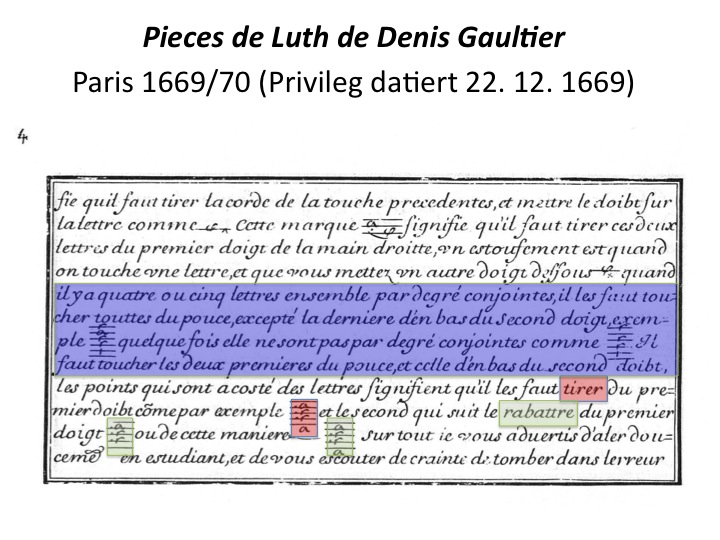
Pièces de luth de Denis Gaultier, Paris 1669/70 (the privilege is dated to 22 December 1669)
When looking at the technique of Tirer et Rabattre, Gaultier’s system becomes completely opaque, because Tirer (red) and Rabattre (yellow) are indicated by the same signs: dots on the side of (almost) all tablature letters of the chord to be strummed through.

Pièces de luth de Denis Gaultier, Paris 1669/70 (the privilege is dated to 22 December 1669)
Is the strumming direction in the example on the upper left meant to be from high to low or reverse? And in the example on the upper right? In the example below? Contemporaries of Gaultier will have found the fitting answers by listening to the music as it unfolded while they were playing. But what do we do?
The analysis of Bourgaise’s more differentiated use of signs shows that there is no consistent correlation between strong beats and Tirer. Tirer is to be found on strong and on weak beats.
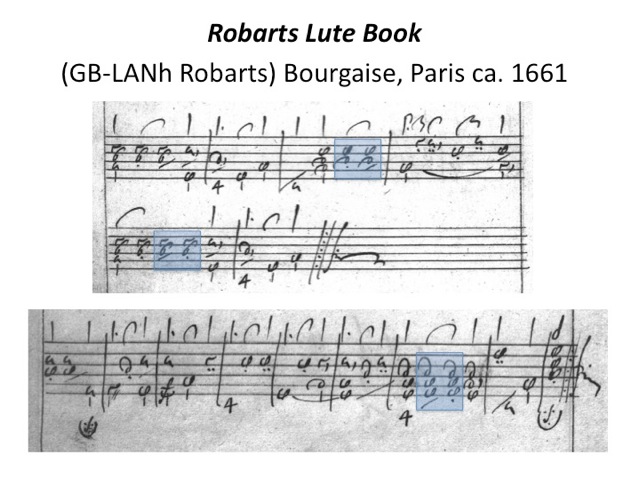
Robarts Lute Book, (GB-LANh Robarts) Bourgaise, Paris c 1661
The open questions concerning the playing technique are the theme of a special chapter in our edition.
I would like to close with a further thought:
The academic editions of 17th-century lute music have the effect that less critical readers may think there is a thing like an Urtext. This would be wrong in two respects:
1. Simultaneousness
Different versions of pieces were circulating at the same time, even if most of these versions should fit into the fomulational latitude’s range.
2. Development with time
Where is a proof for Denis Gaultier playing a piece which he composed in the 1640s until the end of his life without ever changing anything in the music? We do have indications that this was not the case, for example do we find pieces by Charles Mouton in manuscript versions with B parts differing from those which had appeared in print. These versions have been written by Mouton himself onto free pages in his second print, a copy of which is in Nelahozeves.
To sum it up: It is necessary to examine things carefully.
- Copies of printed books need to be understood as examples of works in progress and approached with this concept in mind rather than as single specimens of a finished and standardized print project.
- In manuscripts the different content layers, writers’ hands, the repertoire, and the instrument(s) necessary for playing the music have to be identified, and the chronology both general as with respect to layers and fascicles has to be investigated thoroughly. The manuscript’s genesis has to be described including all possible interpretations. Simplifications caused by the interpreter’s bias are no benefit to anybody.
- In the case of French lute music of the 17th century the formulational latitude is to be explored by comparing different versions of a given piece. This can then be the basis for a personal adaption of the music.
The last two points concern thoughts which I have first aired thirty years ago. The individuality of music prints has only in recent years become a theme, and the discussion of this theme should have far-reaching consequences especially for the cataloguing of prints.
You see: The work for the edition French 17th-Century Lute Sources with Participation of Notator B of the Rhétorique des Dieux has turned, as a consequence of careful examination, from producing a straightforward reproduction of the sources together with concordances, parallel readings and some remarks about the sources to an overall presentation of the French 17th-century lute music’s transmission by reference to the Gaultier sources. We hope to find your understanding for the long delay in the publication caused by this. Finally you will have an extraordinary collection of material in your hands, which will allow to develop new perspectives for studies, and lead to new discoveries. Of course it can be used for the sole purpose of playing the music, but the invitation to explore by yourself is open. We look forward to you approaching this music, which has fascinated us for such a long time.
Appendix 1: Genealogy of the family de Chambré
Appendix 3: Example of a piece in the Gaultier Catalog Raisonné
(Addition 2016: This will not be published in the form shown in this appendix; compare the Addition 2016 in the chapter The Gaultier Catalog Raisonné)
Notes
1 This lecture was held on 1 June 2013 in Bremen during the annual lute festival of the German lute society. Updates mirroring our present state of research (set in italics and headed Addition 2016) have been inserted into the text at the appropriate places. In the notes, call numbers of sources are only given when these also appear in the presentation shown during the lecture.
2 Andreas Schlegel, Bemerkungen zur Rhétorique des Dieux (part 1: Zur Entstehungsgeschichte; part 2: Die Tabulatureinträge vor dem stilistischen Hintergrund der französichen Lautenmusik des 17. Jahrhunderts; part 3: Die Tabulatureinträge in der “Rhétorique”), in: Gitarre & Laute 11 (1989) 2 pp. 17–23; 3 pp. 17–23; 4 pp. 27–32.
3 Andreas Schlegel, Der Codex Hamilton als periphere Quelle der Werke Denis Gaultiers, paper for the tutorial “Einführung in das Lesen musikalischer Texte des 17. und 18. Jahrhunderts” (Introduction to reading musical texts of the 17th and 18th century) guided by Prof. W. Arlt, Musicological Institute of the Basel University, 1987.
4 François-Pierre Goy, Anne-Achille de Chambré et sa famille, in: Tablature (Bulletin de la Société française de luth) 12/3 (1996), pp. 8–11.
5 Paris, Archives nationales, MC/ET/XIII/105, 5 July 1685.
6 This was done to secure the personal property of the wife, which she had brought into the marriage, in the case that the man got into financial difficulties.
7 Paris, Bibliothèque nationale de France, départment des Estampes et de la photographie, VD-31 (2)-FT 4.
8 Paris, Archives nationales, MC/ET/CII/55, 4 November 1663.
9 Paris, Archives nationales, MC/ET/XIII/152, 7 May 1706.
10 Paris, Archives nationales, Y//12559.
11 Paris, Archives nationales, MC/ET/XXXIV/357, 24 December 1711.
12 “Item un livre de lut remply de plusieurs figures en taille dousse, relié de chagrin, garny de ses fermoirs et d’agremens de cuivre avec son sacq de velours sizelé, prisé vingt livres.”
13 Rouen, Archives départementales de Seine-Maritime, 4 E 2720. She died on 22 June at the age of 84 years and seven months, and was buried two days later.
14 Rouen, Archives départementales de Seine-Maritime, 3 E 113/33, 2 April 1742.
15 Paris, Archives nationales, MC/ET/LXI/240, 29 June 1664.
16 La Rochelle, Archives départementales de Charente-Maritime, without call number, 26 August 1635.
17 In the lecture, a photograph of the certificate of her baptism (Lyon, Archives municipales, 1 GG 575, 20 September 1649) was shown.
18 Paris, Bibliothèque nationale de France, Département des Manuscrits, Français 21945, fol. 119r.: “Du quatriesme juillet 1672. Le sieur Girin, marchand libraire à Lyon, nous a presenté un privilege à luy accordé pour l’impression d’un livre intitulé L’art d’apprendre seul à jouer facilement et en peu de temps la musette, ensemble la teorie et pratique sur le luth et ce pour le temps de dix années en date du 16 fevrier 1672.”
19 The handwritten ascriptions “Par Mr de Montarcis” on the title pages of the Munich and a number of further copies of the Traité de la raison are probably autographs of the author.
20 Œuvres du Vieux Gautier, edited by André Souris and Monique Rollin, 1st edition 1966, 2nd enlarged edition 1980; Œuvres de Pierre Gautier, edited by Monique Rollin, 1984; Œuvres de Denis Gautier, edited by Monique Rollin and François-Pierre Goy, 1996. In the Corpus the modern spelling Gautier is used. This can in fact be found in some lute sources, but all three composers used the spelling Gaultier in their prints or in their signature (no print however by Ennemond Gaultier appeared in his lifetiem, and any example of Pierre Gaultier’s signature is lacking).
21 Pièces de luth: Tombeau de Raquette, pp. 8–11; Livre de tablature: La dédicace, pp. 42–43, measure 18.
